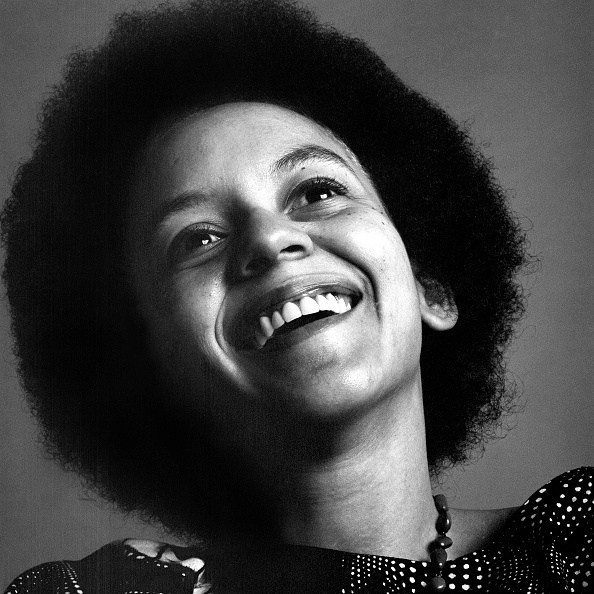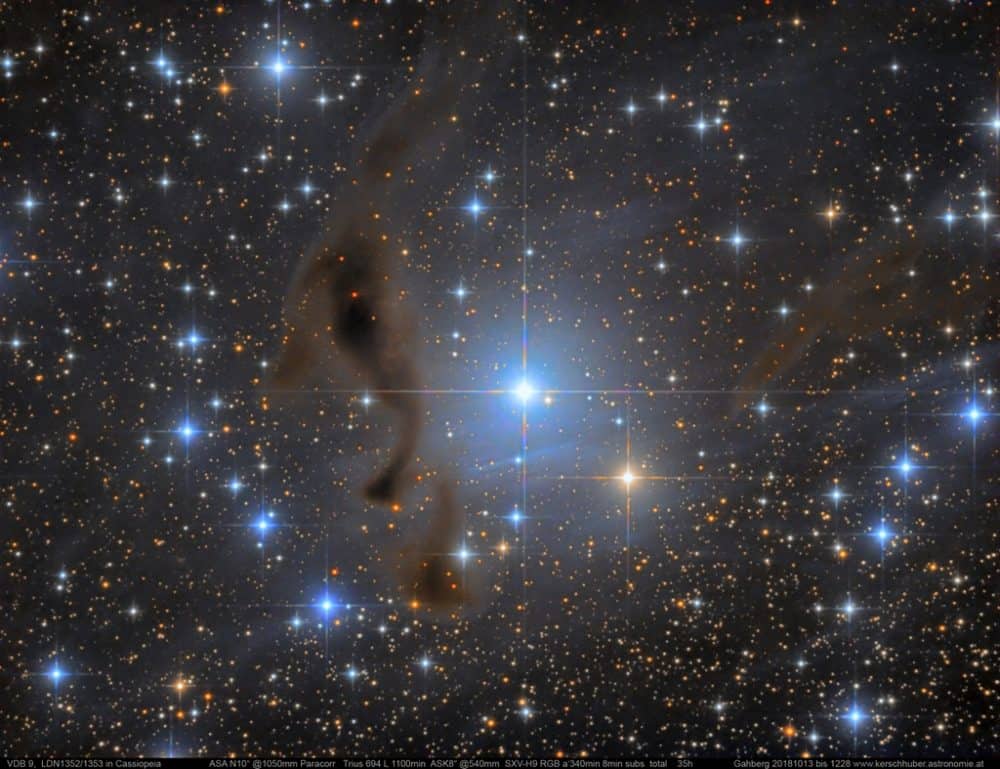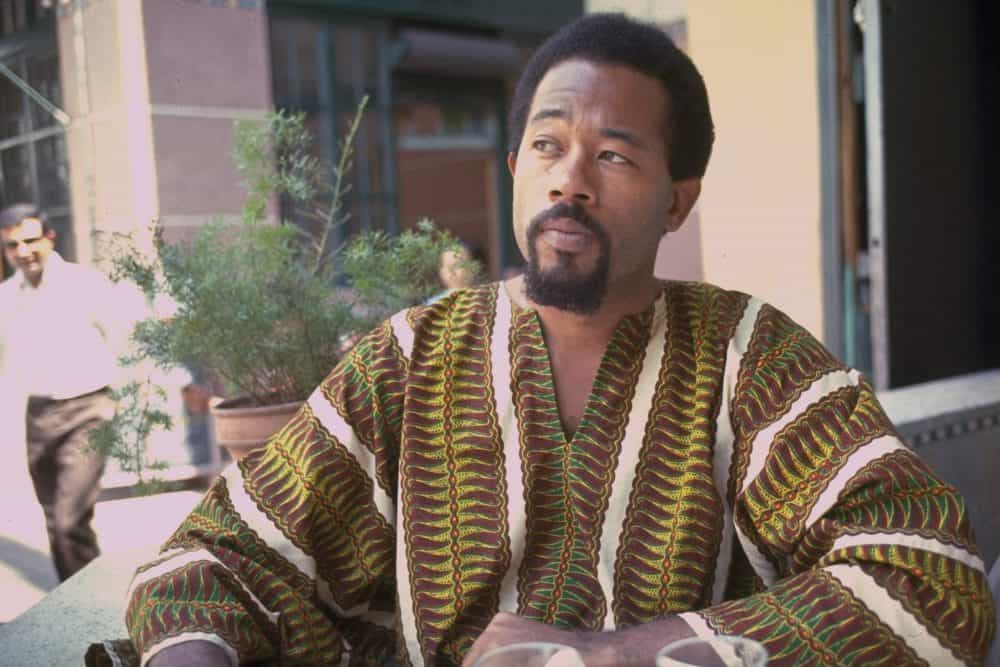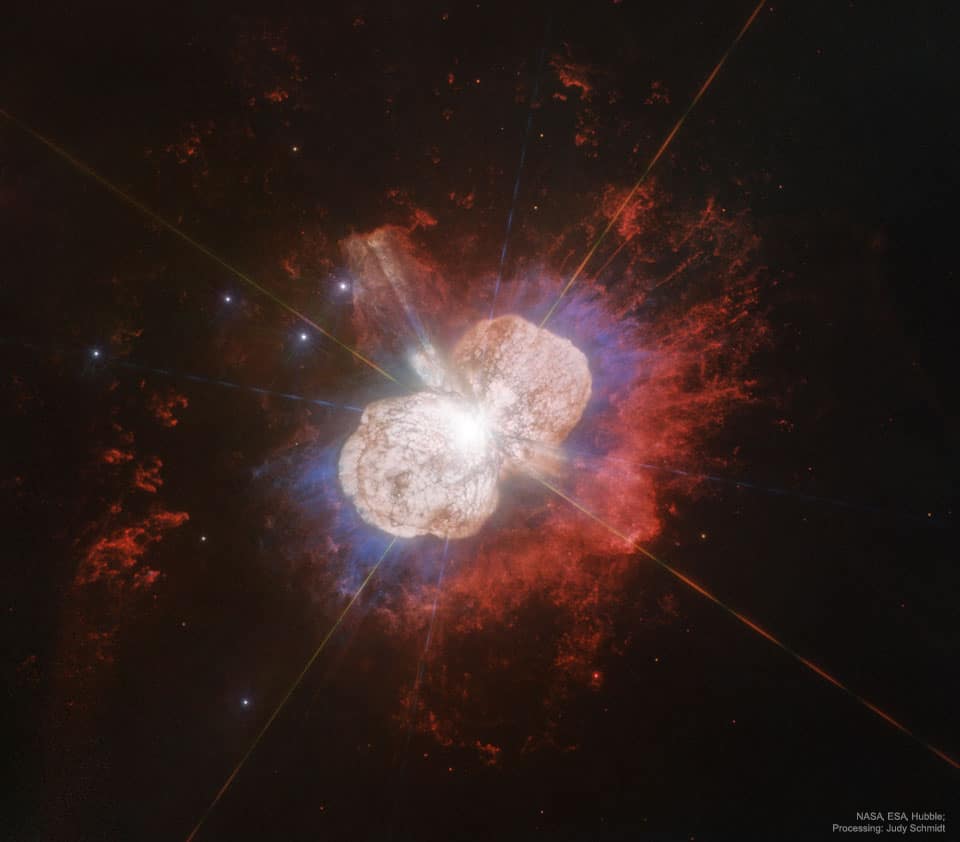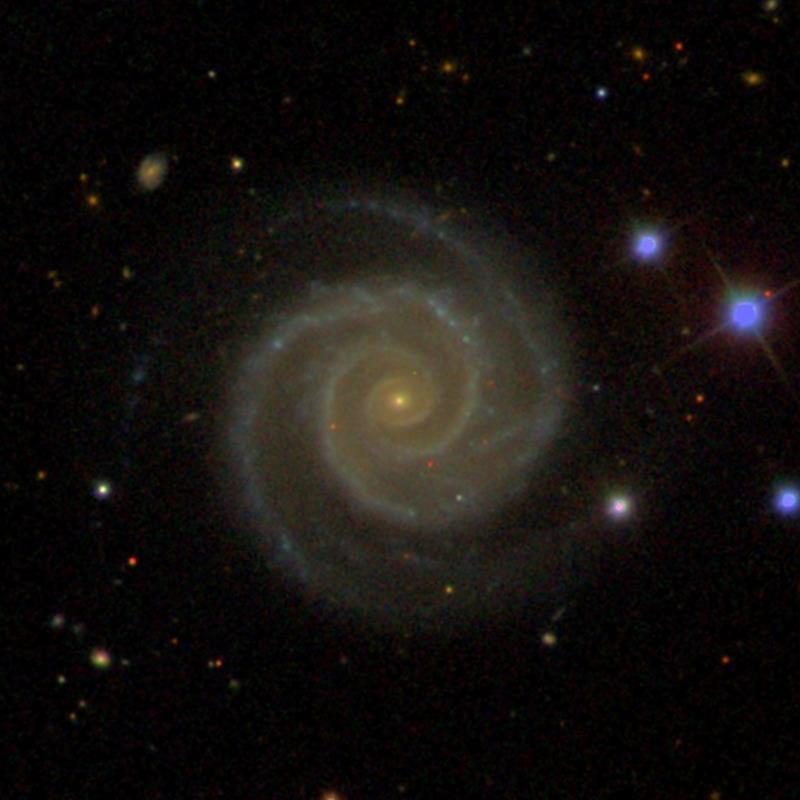Blog
https://www.youtube.com/watch?v=4bUmzzegEwU
more...Centered in a well-composed celestial still life, pretty, blue vdB 9 is the 9th object in Sidney van den Bergh’s 1966 catalog of reflection nebulae. It shares this telescopic field of view, about twice the size of a full moon on the sky, with stars and dark, obscuring dust clouds in the northerly constellation Cassiopeia. Cosmic dust is preferentially reflecting blue starlight from embedded, hot star SU Cassiopeiae, giving vdB 9 the characteristic bluish tint associated with a classical reflection nebula. SU Cas is a Cepheid variable star, though even at its brightest it is just too faint to be seen with the unaided eye. Still Cepheids play an important role in determining distances in our galaxy and beyond. At the star’s well-known distance of 1,540 light-years, this cosmic canvas would be about 24 light-years across.
more...Edward Haydn Higgins (February 21, 1932 – August 31, 2009) was a jazz pianist, composer, and orchestrator.
For more than two decades Higgins worked at some of Chicago’s most prestigious jazz clubs, including the Brass Rail, Preview Lounge, Blue Note, Cloister Inn and Jazz, Ltd. His longest and most memorable tenure was at the long-gone London House, where he led his jazz trio from the late 1950s to the late 1960s, playing opposite jazz stars of this period, including Cannonball Adderley, Bill Evans, Erroll Garner, Stan Getz, Dizzy Gillespie, Wes Montgomery, Oscar Peterson and George Shearing, among others. Later, Higgins said the opportunities to play jazz music with Coleman Hawkins and Oscar Peterson were unforgettable moments. Higgins spent his time at the London House Restaurant with bassist Richard Evans and drummer Marshall Thompson. Higgins also worked for Chess Records as a producer.
During his stay in Chicago, Higgins also recorded a significant number of albums under his auspices and many more as a sideman with a wide variety of musicians, ranging in style from tenor saxophonists Hawkins to Sonny Stitt to Wayne Shorter; trumpeters Bobby Lewis to Harry Edison to Lee Morgan and Freddie Hubbard; and trombonists Jack Teagarden to Al Grey. His versatility was captured on stage and records, backing up singers and leading his own projects as both pianist and orchestrator, working in every jazz circle from dixieland to modal styles. Although he opted to decline the offer, Higgins was asked at one point by Art Blakey to join the seminal hard bop quintet, The Jazz Messengers.
https://www.youtube.com/watch?v=k9BqZxir_AI
more...Corey Harris (born February 21, 1969; Denver, Colorado) is an American blues and reggae musician, currently residing in Charlottesville, Virginia. Along with Keb’ Mo’ and Alvin Youngblood Hart, he raised the flag of acoustic guitar blues in the mid-1990s. He was featured on the 2003 PBS television mini-series, The Blues, in an episode directed by Martin Scorsese.
Harris was born and raised near Denver, Colorado. He graduated from Bates College in Lewiston, Maine with a bachelor’s degree in 1991, and was awarded an honorary doctorate in 2007. Harris received a Thomas J. Watson Fellowship for language studies in Cameroon in his early twenties, before taking a teaching post in Napoleonville, Louisiana under the Teach For America program. His debut solo album Between Midnight and Day (1995) was produced by composer/producer Larry Hoffman, who discovered him in 1994 in Helena, AR. The record included covers of Sleepy John Estes, Fred McDowell, Charlie Patton, Muddy Waters, and Booker White.
In 2002, Harris collaborated with Ali Farka Toure on his album Mississippi to Mali, fusing blues and Toure’s music from northern Mali. In 2003, he contributed to the Northern Blues release Johnny’s Blues: A Tribute To Johnny Cash.
more...Eunice Kathleen Waymon (February 21, 1933 – April 21, 2003 Tryon, NC), known professionally as Nina Simone (/ˈniːnə
Born in North Carolina, the sixth child of a preacher, Waymon initially aspired to be a concert pianist. With the help of a few supporters in her hometown of Tryon, she enrolled in the Juilliard School of Music in New York.
Waymon then applied for a scholarship to study at the prestigious Curtis Institute of Music in Philadelphia, where she was denied admission despite a well-received audition. Waymon became fully convinced this rejection had been entirely due to racial discrimination. In 2003, just days before her death, the Curtis Institute of Music bestowed on her an honorary degree.
To make a living, Waymon started playing piano at a nightclub in Atlantic City. She changed her name from Eunice Waymon to “Nina Simone” to disguise herself from family members, having chosen to play “the devil’s music” or “cocktail piano”. She was told in the nightclub that she would have to sing to her own accompaniment, which effectively launched her career as a jazz vocalist.
Simone recorded more than 40 albums between 1958 and 1974. She made her debut with the album Little Girl Blue. She had a hit in the United States in 1958 with “I Loves You, Porgy“.
Simone’s musical style fused gospel and pop with classical music, in particular Johann Sebastian Bach, and accompanied expressive, jazz-like singing in her contralto voice.
more...Eta Carinae may be about to explode. But no one knows when – it may be next year, it may be one million years from now. Eta Carinae‘s mass – about 100 times greater than our Sun – makes it an excellent candidate for a full blown supernova. Historical records do show that about 170 years ago Eta Carinae underwent an unusual outburst that made it one of the brightest stars in the southern sky. Eta Carinae, in the Keyhole Nebula, is the only star currently thought to emit natural LASER light. This featured image brings out details in the unusual nebula that surrounds this rogue star. Diffraction spikes, caused by the telescope, are visible as bright multi-colored streaks emanating from Eta Carinae’s center. Two distinct lobes of the Homunculus Nebula encompass the hot central region, while some strange radial streaks are visible in red extending toward the image right. The lobes are filled with lanes of gas and dust which absorb the blue and ultraviolet light emitted near the center. The streaks, however, remain unexplained.
more...Leroy Jones (born February 20, 1958) is a jazz trumpeter from New Orleans, Louisiana. Jones began playing trumpet at the age of ten, and by the time he was 12 was leading the Fairview Baptist Church Marching Band, a group of young musicians organized by guitar– and banjo-player Danny Barker. When the musicians’ union forced Barker to disband the group in 1974, Jones became a union musician and took over the running of the group, renamed the Hurricane Brass Band, himself. In 1975 or 1976 he left the group, touring for a time with Eddie Vinson and Della Reese before forming his own group, the Leroy Jones Quintet. In 1991 Jones joined the big band of Harry Connick, Jr., and the exposure with Connick’s band (including the opportunity for the Leroy Jones Quintet to open for Connick, which they did in 1994), led to Jones’ releasing his first album under his own name; Mo’ Cream From The Crop came out on the Columbia Records label in 1994. The Leroy Jones Quintet continues to tour and record, and since 2004 Jones has also appeared with the Preservation Hall Jazz Band and Dr. John.
more...Oscar Marcelo Alemán (February 20, 1909 – October 14, 1980) was an Argentine jazz guitarist, singer, and dancer. He is widely recognized in his country and abroad as one of the best jazz performers, and as an influential artist.
At the age of six, Alemán joined the family ensemble, the Moreira Sextet, and played the cavaquinho, a Brazilian ukulele, before taking up the guitar. The group travelled to Buenos Aires to perform at the Parque Japonés, Nuevo Theater, and at the Luna Park. Later they toured in Brazil.
Alemán was orphaned at age of ten when his mother died and his father committed suicide. He sustained himself by working sporadically as a dancer and musician on the streets of Santos, Brazil. When he saved enough money, he bought a guitar and started to play professionally at party venues in a duo called Los Lobos with his friend, Brazilian guitarist Gastón Bueno Lobo. The duo moved to Buenos Aires in 1925 to work under contract for the comedian Pablo Palitos. In Buenos Aires, they formed a trio with violinist Elvino Vardaro. They added tango to their repertoire and recorded with Agustín Magaldi. They later played with Carlos Gardel and Enrique Santos Discépolo.
more...“There is a higher law than the law of government. That’s the law of conscience.” Stokely Carmichael
more...NGC 2857 (also known as Arp 1 and PGC 26666) is a spiral galaxy in the constellation Ursa Major. It was discovered on January 9, 1856 by R. J. Mitchell.
NGC 2857 is the first object in Halton Arp’s Atlas of Peculiar Galaxies, and one of six Arp objects in the ‘Low Surface Brightness Galaxies’ section. Distance 69.050 ± 00 kpc
more...
William “Smokey” Robinson Jr. (born February 19, 1940) is an American singer, songwriter, record producer, and former record executive. Robinson was the founder and frontman of the Motown vocal group the Miracles, for which he was also chief songwriter and producer. Robinson led the group from its 1955 origins as “the Five Chimes” until 1972 when he announced a retirement from the group to focus on his role as Motown’s vice president.
However, Robinson returned to the music industry as a solo artist the following year. Following the sale of Motown Records in 1988, Robinson left the company in 1990. He was inducted into the Rock and Roll Hall of Fame in 1987. Robinson was awarded the 2016 Library of Congress Gershwin Prize for his lifetime contributions to popular music. Smokey Robinson was born to an African-American father and a mother of African-American and French ancestry into a poor family in the North End area of Detroit. His uncle Claude gave him the nickname “Smokey Joe” when he was a child. He attended Northern High School, where he was above average academically and a keen athlete, though his main interest was music and he formed a doo-wop group named the Five Chimes. At one point, he and Aretha Franklin lived several houses from each other on Belmont; he once said he has known Franklin since she was about five.
more...Louis “Kid Shots” Madison (born February 19, 1899 in New Orleans , † September 1948 ibid) was an American jazz trumpeter ( cornet ).
Madison taught cornet lessons with Davey Jones , Joe Howard and Louis Dumaine . In his youth, he played in a street band with Louis Armstrong (where he took over the drums). He played in the Eagle Brass Band and from 1923 to 1925 in the Original Tuxedo Orchestra by Oscar Celestin . He then spent a year in the band of William Ridgley and in the Great Depression in the State-sponsored Worker’s Program Association brass band in New Orleans. In the 1940s he played in the Young Tuxedo Band and in the Eureka Brass Band . In the 1940s he had a day job at the health department and evening play at the Cadillac Club and later at Lake Pontchartrain . In 1948 he had a stroke and gave up the music.
He recorded with George Lewis and in 1945 in a band directed by Bunk Johnson .
more...https://www.youtube.com/watch?v=nCEY9wrKb5M
more...More Posts
- Randy Crawford
- Irma Thomas
- World Music Fanfare Ciocarlia
- Daily Roots Dr Alimantado
- Echos of Freedom by Alice Walker
- Miles Davis
- Cosmos Comet 12P/Pons-Brooks
- Fred Frith
- Buddy DeFranco
- World Fusion Subhen Chatterjee
- Daily Roots Yabby You
- Aston Family Man Barrett Memorial
- Donald Kinsey Memorial
- Temple Israel Erev Shabbat 2-16-24
- Cosmos HFG1 & Abell 6
- Buddy Deppenschmidt
- Bill Doggett
- Joe Venuti
- Flamenco Fridays Camarón y Paco Cepero
- Daily Roots Bob Marley
